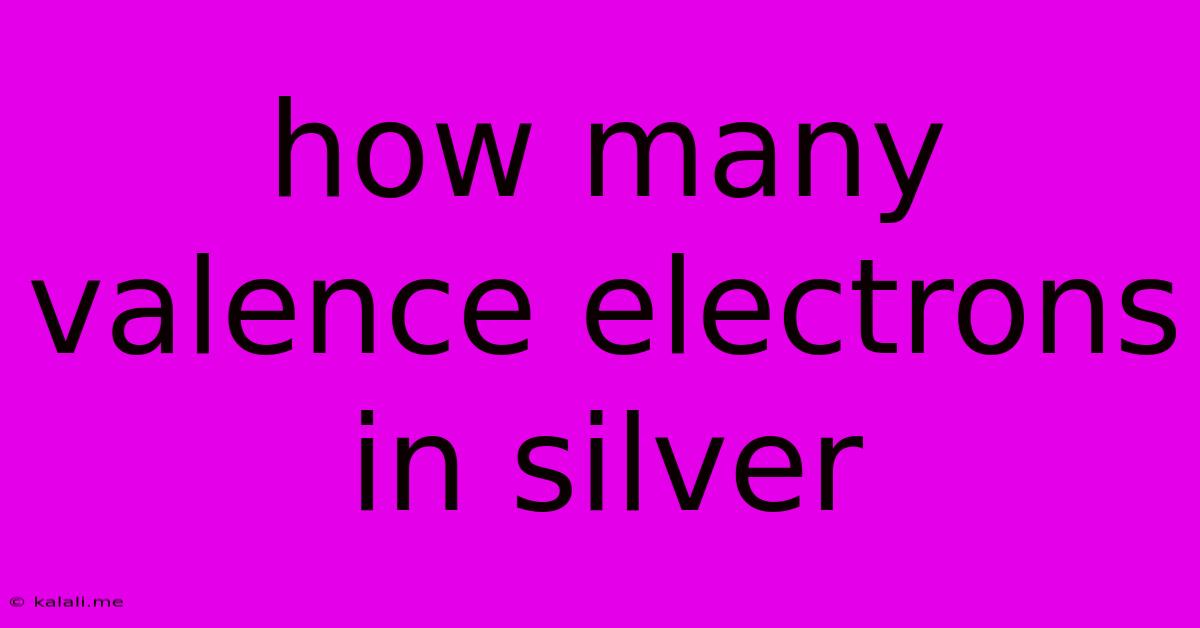How Many Valence Electrons In Silver
Kalali
Jun 15, 2025 · 2 min read

Table of Contents
How Many Valence Electrons Does Silver Have? Understanding Silver's Reactivity
Silver, a lustrous and precious metal, finds applications in diverse fields, from jewelry to electronics. Understanding its chemical behavior requires knowledge of its electronic structure, particularly the number of valence electrons. This article will delve into the atomic structure of silver and definitively answer the question: how many valence electrons does silver have? We'll explore the concept of valence electrons, their role in chemical bonding, and how this impacts silver's properties.
Silver's atomic number is 47, meaning it possesses 47 protons and, in its neutral state, 47 electrons. These electrons are arranged in specific energy levels or shells surrounding the nucleus. The outermost shell, which dictates an element's reactivity and bonding behavior, contains the valence electrons.
Electron Configuration and Valence Electrons
To determine the number of valence electrons in silver, we need to examine its electron configuration. The electron configuration of silver is [Kr] 4d¹⁰ 5s¹. While the traditional understanding might suggest one valence electron (the 5s¹ electron), the situation with transition metals like silver is more nuanced.
The d-orbital electrons can participate in bonding, blurring the lines between core and valence electrons. Although the 4d orbitals are considered inner shells, they are close enough in energy to the 5s orbital to participate in chemical bonding under certain conditions.
Therefore, while silver typically exhibits a +1 oxidation state, losing its single 5s electron, it can also show higher oxidation states (+2, and rarely +3) involving participation of the 4d electrons. This explains silver's ability to form a variety of compounds with differing oxidation states.
Silver's Reactivity and Valence Electrons
The single 5s electron is responsible for silver's relatively low reactivity compared to other transition metals. This low reactivity contributes to its resistance to corrosion and its status as a noble metal. However, the involvement of the 4d electrons allows for a wider range of chemical behaviors than a simple +1 oxidation state would suggest.
It’s important to note that while the 4d electrons can participate in bonding, the single 5s electron is the primary contributor to silver's chemical reactivity in most situations. This means that, for practical purposes, we can often consider silver to have one valence electron. However, a complete understanding requires acknowledging the potential contribution of the 4d electrons.
Conclusion: One Valence Electron (with caveats)
In summary, silver typically exhibits a +1 oxidation state and generally behaves as if it possesses one valence electron. However, the proximity of the 4d electrons allows for participation in bonding under specific circumstances, leading to the possibility of higher oxidation states. Therefore, while a simple answer is one, a more nuanced understanding requires acknowledging the potential involvement of the d-electrons in specific chemical reactions. This understanding provides a more complete picture of silver's chemical behavior and reactivity.
Latest Posts
Latest Posts
-
A Piece Of Land Surrounded By Water On Three Sides
Jun 15, 2025
-
Least Common Multiple Of 3 4 And 7
Jun 15, 2025
-
Which Of The Following Is A Metaphor
Jun 15, 2025
-
What Is A Central Idea In This Passage
Jun 15, 2025
-
What Day Of The Week Is November 17
Jun 15, 2025
Related Post
Thank you for visiting our website which covers about How Many Valence Electrons In Silver . We hope the information provided has been useful to you. Feel free to contact us if you have any questions or need further assistance. See you next time and don't miss to bookmark.